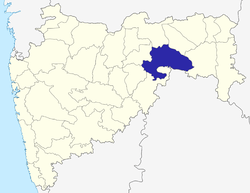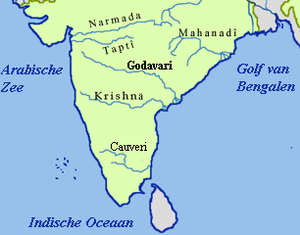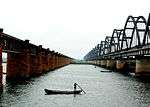Yavatmal district
| Yavatmal district यवतमाळ जिल्हा | |
|---|---|
| District of Maharashtra | |
 Location of Yavatmal district in Maharashtra | |
| Country | India |
| State | Maharashtra |
| Administrative division | Amravati Division |
| Headquarters | Yavatmal |
| Tehsils | 1.Arni, 2.Umarkhed, 3.Kalamb, 4.Pandharkawada Kelapur, 5.Ghatanji, 6.Zari Jamani, 7.Darwha, 8.Digras, 9.Ner, 10.Pusad, 11.Babhulgaon, 12.Mahagaon, 13.Maregaon, 14.Yavatmal, 15.Ralegaon 16.Wani |
| Government | |
| • Lok Sabha constituencies | 1. Yavatmal-Washim (shared with Washim district), 2. Hingoli (shared with Hingoli district), 3. Chandrapur (shared with Chandrapur district). |
| • Assembly seats | 7 |
| Area | |
| • Total | 13,584 km2 (5,245 sq mi) |
| Population (2001) | |
| • Total | 2,460,482 |
| • Density | 180/km2 (470/sq mi) |
| • Urban | 18.60 |
| Demographics | |
| • Literacy | 74.06% |
| • Sex ratio | 942 |
| Average annual precipitation | 1029 mm |
| Website | Official website |
Yavatmal district (![]() pronunciation , Marathi: यवतमाळ जिल्हा), formerly known as Yeotmal, is a district of the Indian state of Maharashtra. It is located in the region of Vidarbha, in the east-central part of the state.[1] Yavatmal town is the administrative headquarters of this district. The incumbent District Collector is Ashwin Mudgal.
pronunciation , Marathi: यवतमाळ जिल्हा), formerly known as Yeotmal, is a district of the Indian state of Maharashtra. It is located in the region of Vidarbha, in the east-central part of the state.[1] Yavatmal town is the administrative headquarters of this district. The incumbent District Collector is Ashwin Mudgal.
History
It is believed that Yavatmal, along with the rest of the erstwhile Berar province, was part of the legendary kingdom of Vidarbha mentioned in the Mahabharata. Berar also formed part of the Mauryan Empire during the reign of Ashoka (272 to 231 BCE). Berar later came under the rule of the Satavahana dynasty (2nd century BCE–2nd century CE), the Vakataka dynasty (3rd to 6th centuries), the Chalukya dynasty (6th to 8th centuries), the Rashtrakuta dynasty (8th to 10th centuries), the Western Chalukya (10th to 12th centuries), and finally the Yadava dynasty of Devagiri (late 12th to early 14th centuries). A period of Muslim rule began when Ala ud din Khilji, Sultan of Delhi, conquered the region in the early 14th century. The region was part of the Bahmani Sultanate, which broke away from the Delhi Sultanate in the mid-14th century. The Bahmani Sultanate broke up into smaller sultanates at the end of the 15th century, and in 1572 Berar became part of the Nizam Shahi sultanate, based at Ahmednagar. The Nizam Shahis ceded Berar to the Mughal Empire in 1595. As Mughal rule started to unravel at the start of the 18th century, Asaf Jah I, Nizam of Hyderabad seized the southern provinces of the empire (including Berar) in 1724, forming an independent state.
A detailed account of Berar was added to the Ain-i-Akbari in 1596-97, immediately after the treaty of Ahmadnagar under which the province was ceded to the empire, and as the Moghal officers cannot have had time, before the account was written, to settle the province and readjust boundaries of its administrative divisions we may regard this description as an account of the province as it was administered by the Nizam Sahi and Imad Sahi kings, and probably also by the Bahamanis. It was divided into thirteen sarkars or revenue districts. The Yavatmal district comprised the greater part of Akbar's sarkars of Kalam and Mahur. But some few mahals of these sarkars lay beyond the present limits of the district. Yavatmal appears in the record as the headquarters of a pargana under the name of Yot-Lohara, Yot being the Urdu or Persian corruption of Yevata, the original name of the town; and Lohara the name of a village about three miles to the west of Yavatmal. The suffix mal is a corruption of mahal (pargana-town). A rough estimate makes the land revenue demand in Akbar's time for the area now occupied by the district rather more than ten lakhs of rupees: but this estimate is rather under than over the mark, while it is certain that collection must always have fallen far short of the nominal demand.
In 1853, the district together with the rest of Berar came under the administration of the British East India Company. Berar was divided into East and West Berar with Yavatmal district being included in East Berar. In 1864, Yavatmal along with some other talukas was formed into the district initially called Southeast Berar and later renamed Wani. In 1903, Berar was leased by the Nizam of Hyderabad to the British Government of India. Cotton is also invented in Yavatmal by "guttsam rishi"
Geography
Yavatmal district is bounded on the north by Amravati District, to the northeast by Wardha District, to the east by Chandrapur District, to the south by Telangana state and Nanded District, to the southwest by Hingoli District, and to the west by Washim District.
Cotton and wheat are the predominant crops grown in the district. The chief rivers flowing through the district are the Wardha and the Penganga. The Wardha is the only river flowing through the district which is partly navigable. The Bembla and the Nirguda are the main perennial tributaries of the Wardha which flow through the district. Adan is other important river in this area.
Divisions
Yavatmal District forms the southeast corner of Amravati Division, which corresponds to the former British Raj province of Berar.
Yavatmal district comprises sixteen tehsils namely:
- Arni
- Babhulgaon
- Darwha
- Digras
- Ghatanji
- Kalamb
- Mahagaon
- Maregaon
- Ner
- Pandharkawada (Kelapur)
- Pusad
- Ralegaon
- Umarkhed
- Wani
- Yavatmal
- Zari Jamani
- Akola Bazar being another important town in the district.
There are seven Maharashtra Vidhan Sabha constituencies in this district, namely:
- Wani and Arni Vidhan Sabha constituencies are part of Chandrapur Lok Sabha constituency.
- Umarkhed Vidhan Sabha constituency is part of Hingoli Lok Sabha constituency.
- Ralegaon, Digras, Yavatmal and Pusad Vidhan Sabha constituencies are part of Yavatmal-Washim Lok Sabha constituency.
Yavatmal town is the administrative headquarters of this district.
Demographics
According to the 2011 census Yavatmal district has a population of 2,775,457,[2] roughly equal to the nation of Jamaica[3] or the US state of Utah.[4] This gives it a ranking of 141st in India (out of a total of 640).[2] The district has a population density of 204 inhabitants per square kilometre (530/sq mi) .[2] Its population growth rate over the decade 2001-2011 was 12.9%.[2] Yavatmal has a sex ratio of 947 females for every 1000 males,[2] and a literacy rate of 80.7%.[2]
As per Census of 2001, 81% of the people are Hindu, 9% Buddhist and 8% Muslim.
Languages
Languages used in the district include Andh, an Indo-Aryan language spoken by 100,000 people.[5]
Marathi is the major language. Other languages spoken are Urdu, Hindi, Gujarati, Sindhi, Banjari, Gondi and Kolami. The dialect used here is known as the Varhadi dialect.
Economy
Jowar and cotton are the main produce of the district. Cotton and teakwood are the chief exports of the district. Other items exported include lime, wooden furniture and oranges.
In 2006 the Ministry of Panchayati Raj named Yavatmal one of the country's 250 most backward districts (out of a total of 640).[6] It is one of the twelve districts in Maharashtra currently receiving funds from the Backward Regions Grant Fund Programme (BRGF).[6]
Transport
National Highway 7 passes through the district.
Religion
The statistics of religion show that Hindus constitute 81% of the population, Animists 13% and Muhammadans 5%. In 1991 the District had 2568 Jains and 209 Chritians. People from all religion castes and creed live together in harmony.
See also
References
- ↑
- 1 2 3 4 5 6 "District Census 2011". Census2011.co.in. 2011. Retrieved 2011-09-30.
- ↑ US Directorate of Intelligence. "Country Comparison:Population". Retrieved 2011-10-01.
Jamaica 2,868,380 July 2011 est
- ↑ "2010 Resident Population Data". U. S. Census Bureau. Retrieved 2011-09-30.
Utah 2,763,885
- ↑ M. Paul Lewis, ed. (2009). "Andh: A language of India". Ethnologue: Languages of the World (16th ed.). Dallas, Texas: SIL International. Retrieved 2011-09-28.
- 1 2 Ministry of Panchayati Raj (September 8, 2009). "A Note on the Backward Regions Grant Fund Programme" (PDF). National Institute of Rural Development. Retrieved September 27, 2011.
External links
 |
Amravati district | Wardha district |  | |
| Washim district Hingoli district |
|
Chandrapur district | ||
| ||||
| | ||||
| Nanded district | Adilabad district, Telangana |
Coordinates: 20°06′N 78°12′E / 20.1°N 78.2°E


